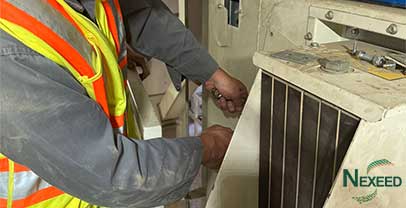Unlocking Efficiency: The Schule TH3 Paddy Table in Oat Processing
In the world of Oat processing, efficiency and precision are paramount. Companies involved in the production of staples like oats recognize the need for precision equipment to streamline their operations. One such standout in the field is the Schule TH3 Paddy Table for those seeking performance in sorting and separating Groats from Oats.
Working with Oat mills in Saskatchewan with locally grown oats one challenge is the hull. Whether it be for flakes or flour the hull is not wanted! One tool in an Oat processing line to eliminate the hull is the Paddy Table.
Precision at Its Core
The Schule TH3 Paddy Table is engineered with precision in mind. Designed to handle the complexities of oats, this table separator ensures accurate sorting and separation of de-hulled oat (groat) from a whole oat. Its advanced technology allows for an exacting separation, resulting in a final product that meets the highest quality standards.
How the Schule Paddy Table Works?
Separation in the compartments of the table separator, which has a specific movement, is caused by zigzag-shaped impact plates which run transversely to the moving direction.
The basis for this mechanical separation process is the fact that kernels of approximately the same shape vary considerably in their specific weight, impact behavior and their sinking capability. As this sounds complex, operating and setting the Shule TH3 is quite simple.

25,000 SCHULE table separators in more than 100 countries
As I mentioned working with Oat mills in Saskatchewan, Canada is certainly one of the countries that Schule has supplied equipment. Nexeed Inc has represented Schule in the Canadian market for the past 3 years. Consumer demand for high quality Oat products is being met on a local level. Seeing the value added to this Western Canadian crop has been an exciting learning experience for myself.

As you can see in the image above, product is fed into the Table in the center, aspiration on each side of that. In the movement of the table and the design of the compartments good Groats come off one side and continue to further processing. Oats come off the other side and are returned to the de-huller.

Only Oats?
My Focus and experience with the Schule TH3 has been with Oats, however these SCHULE table separators are always very successful where conventional sorting processes fail to separate different materials of similar shape and almost the same absolute Weight. Some examples are:
- Food plants
- Seed plants
- Grain shelling plants
- Flour mills
- Maltings
- Other industries (recycling)
In the World of Grain Processing...
In the world of grain processing, the Schule TH3 Paddy Table stands as a testament to excellence. First designed and built by Friedrich Hermann Schule in 1892 experience is on the side of Schule. So if you have a separation challenge in your plant myself and the Team at Nexeed Inc would be happy to help find a solution!
To learn more about Nexeed and Schule please Visit us Here.











